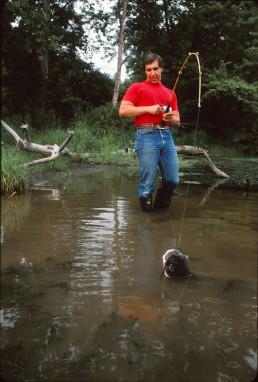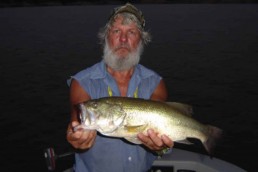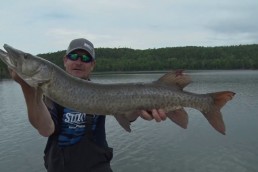Smaller Streams for Hot Cat Action
SHARE THIS POST
It was a hot and humid summer morning; it had rained the night before. When we arrived at the stream, wisps of steam rose from the waters, appearing almost ghost-like as the sun’s rays illuminated the vapors. The water had a perfect coffee color to it and was flowing faster than normal, but not raging. We were fishing downstream from a dam, and the depths of the pools, which were normally between 2 to 5 feet deep, were about a foot deeper, and rising.
I cast my bobber-held nightcrawler to an undercut bank on the opposite shore. It was an easy cast because my target area was only 20 feet away. The bobber floated in the calm water just inside the current’s seam. Down went my bobber, and I instantly set the hook. The rod bowed in a hard “C” as the fish turned tail and headed downstream. Aided by the current, the hard-fighting fish took several minutes to land. It was a handsome 4-pound channel cat. After admiring its shark-like shape, I snapped a couple pictures and released it.
I took another cat from the same hole before the action stopped, and I moved downstream. I caught a catfish or two from each of the five pools that I fished. I quit at noon after catching about a dozen cats, ranging from 12 to 24 inches. Best of all, they all came from a relatively small stream and no one was competing with me for these whiskered battlers.
Fishing for cats in smaller tributaries is an activity few Ohio anglers do. That’s good for me, but bad for them. Not only do a number of these smaller streams have catfish, but some are also a pretty good size. Anglers can have a stream fairly close with action.
Now, it should be pointed out that there are peak times that provide the hottest action. This occurs when the river is rising.
When in doubt where to fish a risin’ river, start at its confluence. In other words, fish where it empties into another stream or a lake. This gives you the best of both worlds. Catfish can be found in the smaller creeks and the increasing creek waters attract cats from the lakes or larger rivers.
The migrating, big-water catfish come into the smaller tributaries looking for a meal. The high water washes down earthworms, insects, caterpillars, etc., which they gorge on. Also, the higher current causes baitfish and crayfish to move to new locations, making them vulnerable to whiskered predators. As they swim upstream, the catfish literally have a smorgasbord of delicacies to choose. They are voracious because it doesn’t take long for a small stream to start receding.
To attack these fish, go the holes closest to the creek’s mouth. Here, some anglers simply cast their baited hooks into the calm pool and wait for the fish to come to them. This patient wait-and-see method produces, however when the creek is high and muddy, I like to walk upstream from hole to hole. Often, this involves a bobber baited with a nightcrawler or cut chub. Set the bait so it is just floats above the bottom. Toss it upstream and let it drift through the pool. Here, the cats wait for the bait to be brought to them. Before leaving the spot, hit all portions of the calm water. Fish the hole until they stop biting, and be ready to walk because these fish are often on the move.
Go upstream to the next piece of slack water. In these high waters, sometimes the bobber drifts too fast. When this happens, remove the float and put a split shot about 1 foot ahead of the hook. Use a lead heavy enough to keep the bait from bouncing downstream along the bottom. When the line stops or a hard tug is felt, set the hook and hang on. In the current, a catfish’s power is greatly increased. Don’t be surprised if you have to move downstream to keep him from spooling your reel or snagging your hook in a log. This is why 12-pound-test or heavier is advised—use a tough monofilament.
Are you enjoying this post?
You can be among the first to get the latest info on where to go, what to use and how to use it!
When the creek recedes, the cats that migrated from the lake or larger stream head downstream, back to the bigger waters. However, their departure does not mean the creek is void of whisker fish. They are there if the angler knows what to look for. As the stream recedes, pools that held fish during higher waters now may only be 1 or 2 feet deep. These resident fish want deeper waters and shade.
Of course, early morning and dusk are prime times; fish are active during these low-light periods. As the sun rises, look for deeper waters under banks with long overhanging tree limbs. Deep pools with logjams offer plenty of shade and protection during the daylight hours. However, tough fishing lines, strong hooks and stout rods often are needed to pry the bigger cats from these labyrinths.
Personally, circle hooks are preferred in logjams because they are less likely to snag on a log or branch. When fishing them, remember not to set the hook. Simply start cranking the reel handle when there is a bite.
If looking for bullhead catfish, be at the fishing hole at just about dark. A hook baited with nightcrawlers can quickly produce a strike from these tasty panfish-sized cats. Don’t be surprised if the action only lasts and hour or two after sunset.
For channel cats, my top two baits are cut chubs and Sonny’s Stink Bait. The angler can bring his own chubs or simply catch them in the catfish creek. To do this, take a size 8 or 10 hook, bait it with a maggot or small piece of worm, and at the head of the hole or in a small pool, start catching your bait. Before putting them on the hook, cut the chub crosswise into two or three pieces—the parts containing intestines are the best.
The stink bait is simply placed on the bait holder, which is a plastic worm with holes and grooves in it. It must be dry for the bait to stick. When using stink bait, bring along plenty of paper towels to dry it off before re-baiting it. The worse it smells to you, the better the channel cats will like it.
Simply cast your baits near the logs or the undercut bank and let the current waft the delicious odors downstream. At night, fish one rod’s bait on the bottom and float another bait under a bobber. This bobber method is especially effective where tree limbs overhang the pool. After dark, the cats prowl the water under these branches looking for fallen insects, floating dead minnows or panfish.
This year, think small. The “right” smaller stream can yield some really nice catches of cats.
MWO
SHARE THIS POST
Did you enjoy this post?
You can be among the first to get the latest info on where to go, what to use and how to use it!
Paul Liikala
Paul Liikala was raised on a farm which was close to Lake Erie and the Grand River. He was fortunate to have parents who nurtured his love for the outdoors. His only hope is that his writings show the love and admiration that he has for the Great Outdoors and its participants.



